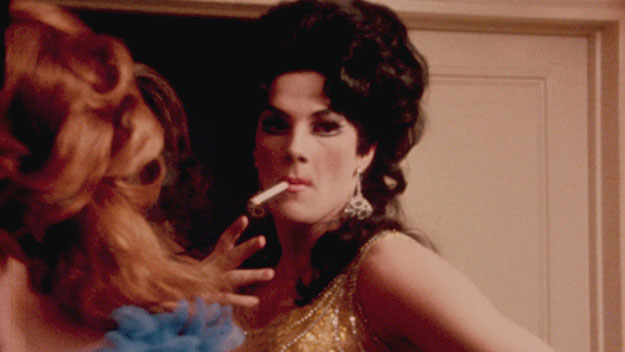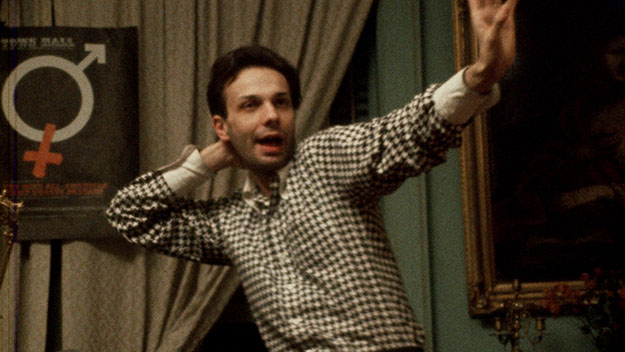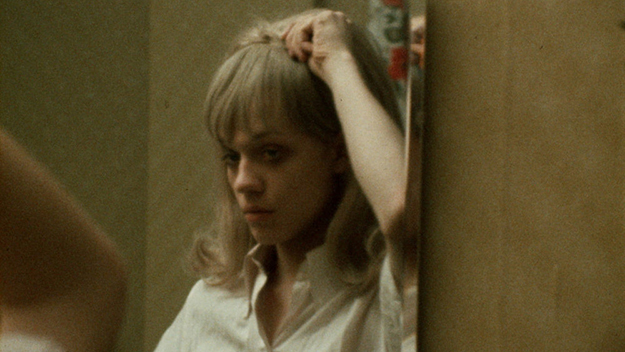Queer & Now & Then: 1967
In this biweekly column, Michael Koresky looks back through a century of cinema for traces of queerness, whether in plain sight or under the surface. Read the introductory essay.

Images from The Queen (Frank Simon, 1967)
Every June, it seems the queer world begins scouring contemporary and classic cinema for images of pride. Because the word has long been a centerpiece of the LGBTQ movement, it’s easy to forget how hard-won pride has been and continues to be, in both individual and wider social contexts. The queer viewer might be particularly inclined to feel a twinge of panic in seeking out those rare films imbued with positivity, whether emanating from the characters on screen or from behind the camera. And while the desperate need for positive images in our culture runs the risk of devaluing the experiences and artistic expressions of those for whom struggles with the self have always been very present, it’s undeniably elating to uncover those buried treasures that give a glimpse into the variegated experiences of queer people throughout history.
We mustn’t forget that the lives of out queer people have not historically been documented on film at all. So Frank Simon’s The Queen, a nonfiction portrait of self-identifying gay men as they prepare for a national drag competition in New York, feels particularly special. This is 1967, and these contestants are getting ready for the annual Miss All-America Camp Beauty Pageant at Town Hall, to which Simon gives us physical access, and for which 24-year-old narrator Jack Doroshow, aka Flawless Sabrina, provides context and insight. Experiential rather than agenda-driven, The Queen is barely known outside of queer circles; outside of the odd cinematheque retrospective, the film is rarely mentioned alongside the groundbreaking 1960s vérité docs such as those by the Maysles or D.A. Pennebaker, despite the fact that its revelations are legion, its access rare, its perspective tender, its shooting and editing cut-to-the-heart sharp. In his 1972 book Screening the Sexes, the great queer critic Parker Tyler praised the film for being a “whole, soberly conceived documentary film” about gay people, a rarity for an industry in which “homosexual phenomena are tolerated in the movies the way society itself tolerates such things. It’s just there. Let it be.” Though it focuses exclusively on this one event, Simon, by keeping his camera open and present, manages to convey so much about the moment, a snapshot of 1967, shot in New York two years before the Stonewall riots, that speaks to the biases and cultural blind spots even in this marginalized milieu. The Queen both allows viewers to receive images of unashamed gay men inhabiting their own bodies—and clothes—with pride, and bears witness to simmering tensions even within its ostensible queer safe spaces.
An overused word in writing about behind-the-scenes documentary work is “intimate,” but I can’t think of a better way to describe a film in which a group of men, in between fittings and makeup tests and performance rehearsals, splay themselves out on a hotel room bed and freely gab about their parents and husbands, their identification with masculinity or femininity, their perspectives on gender reassignment surgery, their experiences being rejected by the military draft board for being homosexual. Then, another thunderbolt: one of the men says that he sent a letter to the President asking to be able to fight for his country; though turned down yet again in response, he was told that hopefully in the future this could be changed.

These sorts of moments—of putting specific human faces and voices to larger social debates that we may think of as having once been merely theoretical—remind us of the ability of film to act as a catalog of human emotion. While watching The Queen, one feels privileged to be in the company of these people, such as Joey, who’s in charge of the East Coast contest and who acts as a kind of den mother, flitting about like Edith Head; or lithe, blond Richard from Philadelphia, a dead ringer for Cameron Diaz when in drag; or certainly pioneering Black queen Crystal LaBeija, whose climactic loss at the competition fuels the film’s fiery final parting shot. The mainstream cultural invisibility of these three, and all the other divine performers like them, has been because of their unapologetic flamboyance rather than in spite of it, one of the classic historical contradictions of out-and-proud queers—the louder we are, the more we have been socially silenced. There’s a fleeting, telling moment early in the film when, upon arriving at Joey’s apartment, one of the show’s eventual contestants conveys momentary surprise and hesitation upon spotting the camera, clearly not used to being seen or documented at all.
What’s most unusual to see onscreen, in 1967 or really any year of the 20th century, is their self-definition and determination. The opening shot of the film is of a dangling earring sparkling in the dark, almost abstracted, yet it’s a rather misleading image: the film is not interested in fetishizing the accoutrements of drag. Furthermore, with its pastel blue and white gowns, and “respectable” choreography, the competition seen in the film’s second half is a relatively subdued affair, modeled on a traditional beauty pageant. Though there are images of teased wigs, talk of beard-covering foundation, and an informative visual précis on the best way of creating cleavage with tape, this is more because the film is dedicated to recording process. There is no sense of gawking from the sidelines; it’s worth considering that just one year later Mel Brooks would handily mock drag in The Producers, with Christopher Hewitt’s Broadway director Roger De Bris in a form-fitting evening dress extolling his love-hate for “gooey gowns.” Simon’s fascination has less to do with the costumes and makeup than the men themselves, and he is far more dedicated to listening to them than looking at them.

Following the film’s almost reverie-like glimpses of the men in preparation (at one extraordinary moment as they apply eyeliner and makeup, the sound cuts out completely, until a distant siren brings us back to reality), Simon takes us into the competition; it’s a testament to his overall experiential approach that such figures as Andy Warhol, taking part as a judge, and Factory drag superstar Mario Montez, on hand to perform a throaty version of “Diamonds Are a Girl’s Best Friend,” appear without much fanfare. The contest moves from ball gown to bathing suit—the latter set amusingly, incongruously to the standard “Am I Blue?”—and culminates in the crowning of Richard, aka the demure Miss Harlow. Earlier in the film, Simon included a brief scene in which Joey remarks upon the ease with which Richard’s lilting, fair-haired ingénue had ascended to drag stardom without really ever having to pay his dues, intimating a jealousy brewing amongst the other queens. Therefore we might not be surprised when some of his competitors react cattily to Miss Harlow’s win, even accusing the jury of fixing the contest.
Crystal LaBeija’s climactic tirade to the camera about Harlow’s triumph is fierce, funny, and somehow feels earned, a denouement that lingers in the mind. It speaks to what Parker Tyler wrote of as the film’s “quite unconscious dignity.” In simply letting Miss Crystal speak her mind on camera—and to camera, as at one point she asks the cameraman about Harlow’s win, “Do you think she deserved it?”—The Queen gives space and time to her anger, and the idea that even in this seemingly more open-minded subculture, normative racist and sexist values very well might remain. The white, blond, soft-spoken Richard, last seen clutching his crown while waiting for a Port Authority bus back to Philly, remains the ideal picture of “femininity” despite his lack of experience and, according to Crystal, shoddy makeup and gown. Crystal’s rant is an example of undeniable pride. It’s genuine, but it’s also the film’s greatest performance.
A new digital restoration of The Queen opens on June 28 at IFC Center.
Michael Koresky is a writer, editor, and filmmaker in Brooklyn. He is cofounder and editor of the online film magazine Reverse Shot, a publication of Museum of the Moving Image; a regular contributor to the Criterion Collection and Film Comment, where he writes the biweekly column Queer and Now and Then; and the author of Terence Davies, published by University of Illinois Press, 2014.







